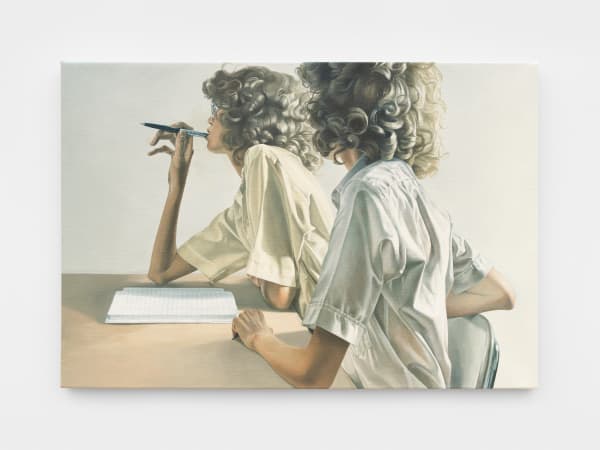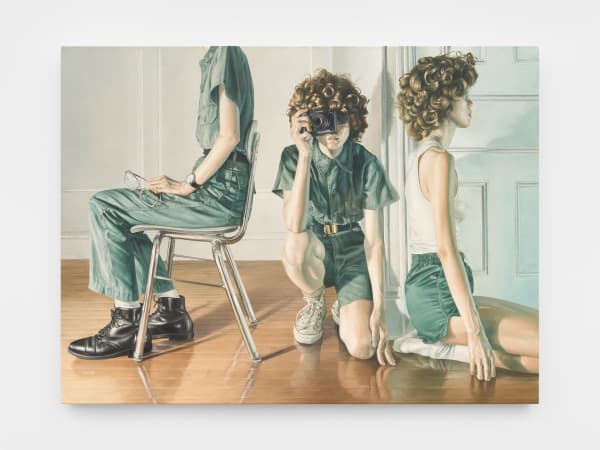After Color Eunnam Hong
Mendes Wood DM is pleased to present After Color, Eunnam Hong's first solo show in Europe at its Brussels gallery space.
Born in 1979 in Ganwang-do, South Korea, but living and working in New York, Hong came to the art world through an unconventional pathway, following an education in graphic design and a career in fashion and advertising. Hong presents her work through meticulous figurative paintings created with oil on linen, thirteen of which will be on view at After Color. Fusing diverse references in cinema and the history of photography, Hong is committed to unveiling issues of representation.
To create the scenes in her work, Hong utilizes her studio/home and her own body, repeatedly posing for the camera and wearing wigs and props while transposing this imagery, forging new aesthetics. This staging exercise allows the artist to face the complexity of living through various identities − those of women, mothers, artists, and immigrants.
An essay by Harry Tafoya accompanies this inaugural exhibition:
It’s not a secret that fashion sells conformity under the promise of individualism, that the glamour of standing out is designed to draw consumers toward buying into mass-produced products. At its highest level, personal style isn’t simply about being attention-grabbing but capturing the full range of a person’s contradictions without resolving them. When Catherine Deneuve, a then-ambassador for Yves Saint Laurent, described the couturier as “[designing] for women who lead double lives,” she was underlining how mutable his clothes were, how they were not only made to be worn but to contain multitudes. To purchase a Saint Laurent piece was to both buy into and opt out of what it meant to be a woman: To be as lovely of a lady or as cavalier as a gentleman, while wearing received ideas of femininity lightly and ironically.
The dilemma of fashion has remained the same, but the contradictions are more ever-present. Not only do we still have to square our public and private selves but our physical and digital selves as well. Social media is a cracked mirror and an echo chamber, reiterating desires we barely have by flooding us with images we barely wish to see. The thrill of a “double life” has been subsumed by the unholy creation of what the writer Meghan O’Gieblyn calls “a second self,” one that is “purely informational and immaterial, a data set of our clicks, purchases, and likes.” If Saint Laurent’s genius was to undo the corset of convention, the modern dilemma is how to assert your individuality while outwitting a digital dead end of our own design.
In her latest show at Mendes Wood DM, Eunnam Hong is in conversation with herself. The dialogue Hong conducts is both public and private, and it’s between her many multiplying selves: Double life by second self by second sex. In her paintings, she stages these gatherings in empty spaces free of distraction, where the business of squaring her angst and alienation can get underway. These are productive voids, places for taking stock. At first glance, they resemble the photographs of Deborah Turbeville or the performances of Vanessa Beecroft: Women posed in bare rooms in elegant clusters, whose glamour is inseparable from their abjection. But stay with them long enough, and you can detect that what’s roiling beneath Hong’s work is far more combustible than assuming the part of a languid surface.
As a working mother, Hong is adept at compartmentalizing, taking on invisible labor, and becoming (out of necessity) a master at hiding in plain sight. In her studio, the artist compounds her own image by doubling as her own model, putting on and casting off wigs, suits, and schoolgirl uniforms. Hong’s gender play is casually queer, a point of identification that’s both deep-seated and worn lightly. The pose she most often strikes is that of an angry young man: Seething, fed-up, painfully aware of being dehumanized by capitalism, in desperate search of a way out. Apart from the Internet, there’s no good time or place for voicing feelings like this, especially the more fully you build out your life. Even then what would she say? “Sometimes I feel like a man,” “I resent only being seen as a mother,” “the world is FUCKED.” How do you voice disillusion without also shaping the algorithm around it?
Throughout the show, Hong offers glimpses of her full spectrum. She’s contemplative and funny in This woman's mukbang (2024), peeking out from behind an overflowing bowl of grapes, with the suggestion that she’s going to devour them all for our amusement. In a painting like Husbands (2024), the air is more somber and middle-aged. Like the John Cassavetes movie it takes its title from, the artist and her duplicates are staring down the barrel at the rest of their lives, the limits of their bravado up against the specter of death. Rather than facing out, Hong and her clones form a secretive huddle. These are paintings that are withdrawn but only temporarily, and with strategy in mind. They are charting a course for how to escape beyond their limits with their sense of selves fully intact.
-
 Eunnam Hong, Spelling, 2024
Eunnam Hong, Spelling, 2024 -
 Eunnam Hong, Authors, 2023
Eunnam Hong, Authors, 2023 -
 Eunnam Hong, This woman's mukbang, 2024
Eunnam Hong, This woman's mukbang, 2024 -
 Eunnam Hong, Memories, 2024
Eunnam Hong, Memories, 2024 -
 Eunnam Hong, POV, 2024
Eunnam Hong, POV, 2024 -
 Eunnam Hong, Beauty and the beast, 2024
Eunnam Hong, Beauty and the beast, 2024 -
 Eunnam Hong, Views, 2024
Eunnam Hong, Views, 2024 -
 Eunnam Hong, Husbands, 2024
Eunnam Hong, Husbands, 2024 -
 Eunnam Hong, Middle, 2024
Eunnam Hong, Middle, 2024 -
 Eunnam Hong, Control, 2024
Eunnam Hong, Control, 2024 -
 Eunnam Hong, Performers, 2024
Eunnam Hong, Performers, 2024 -
 Eunnam Hong, The Kitchen, 2024
Eunnam Hong, The Kitchen, 2024 -
 Eunnam Hong, Submission, 2024
Eunnam Hong, Submission, 2024















